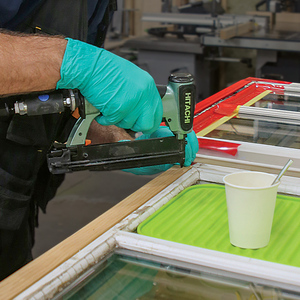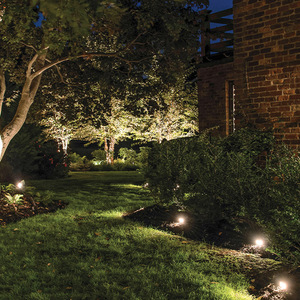A refrigerated warehouse has a small front storage area and a meat cutting area separated by a wall (6″ foam core?, plastic surface – frp?) (W) with swinging double door passage (centerline @ I).
The doors are mounted on wood(?) 2x encased in galvanized sheet metal (G) which is attached to opening (metal cap over wood (J) over foam edge).
In general, the wall rests on a 4″ high concrete curb, except at the passage and 6″ out on both sides where it comes all the way down to the floor. These 6″ spans are covered by a 6″ long galvanized steel coving (C)…
W W
_________ [J][G] [G][J] _______
_________[ C ] I [ C ]_______
Copious amounts of water pours out from under the coving and “jamb” sheet metal cap, leaving rust stains on the floor. Currently, all that’s been done is to put towels down at these spots to soak up the water and place silicone caulking under and against the bottom of the cap and cove to contain the water.
I observed heavy condensation at the header…
They clean the concrete floor at night with hoses. A drain is located about 6 feet away from the centerline of the double doors and the floor slopes (about 3 in 12) from the doorway to the drain…
Today, I was asked to repeat the usual procedure. I raised the cove and dried underneath, removed the old silicone caulking, injected fresh silicone, and released the cove to spring down against the floor again. A short while later, the water was flowing out again.
The warehouse manager, Richard, requested a permanent construction solution. The health inspectors see the rusting on the floor and don’t like it. I would like to relieve Richard’s stress as he anticipates the HIs next visit…
brian



















Replies
The temperature differential coupled with the high humidity of referidgerated food storage makes condensation at that passageway nearly unavoidable. In fact, some may argue that there should be a small rainstorm over the threashold considering the conditions <grin>
Seriously though, if the condensate is flowing out only at the doors, that means that the dewpoint temperature along the rest of the wall is occuring where it should, at some point within the insulation envelope. If the water is flowing out along the entire wall, that means the dewpoint temperature is occuring at one of the wall's surfaces (the side facing the warm area I am guessing)
If the condensation is only at the door, you may be able to solve the problem with and air curtain in addition to the regular doors. If the problem is occuring along the entire wall, you may need to thicken the entire wall with a better insulation solution (or rebuild the wall thicker) and an air curtain at the door.
Additionally, the floor cleaning is probably forcing caustics under the galv. cap. The only solution there is (if you rebuild the entire wall) is to use stainless steel.
I have re-read your post a few times to make sure I am getting all this right and I have one more thing to add. If there is a galv. cap along the entire curb (on which rests the wall) that piece of metal could be what is acting as a conduit for the cold. That cold metal is attracting condensation on the warm side. The washdown is probably forcing water and cleaning solution (Quatenary Ammonia, most likely) under that cap thus causing the rust stains. If you do rebuild the whole thing, you need a thermal break between the cold and warm sides of that cap.
If I have totally gotten this wrong, attach a better drawing so I may better understand the situation.
You don't appreciate my detailed CAD drawing :-(
It was late when I posted. I have qcad on another computer. I won't be able to provide any better drawings...
I'll try to get some digital pix for your review and upload them tonight.
Thanks, Jim
Brian
:-)
The other needs must item on the agenda would be to determine the nature of the cleat material behind the jamb cap. The material is hopefully a composite and not wood, which would act like a sponge.
If this wall is constructed the same as the rest of the warehouse, then it's wood...
brian